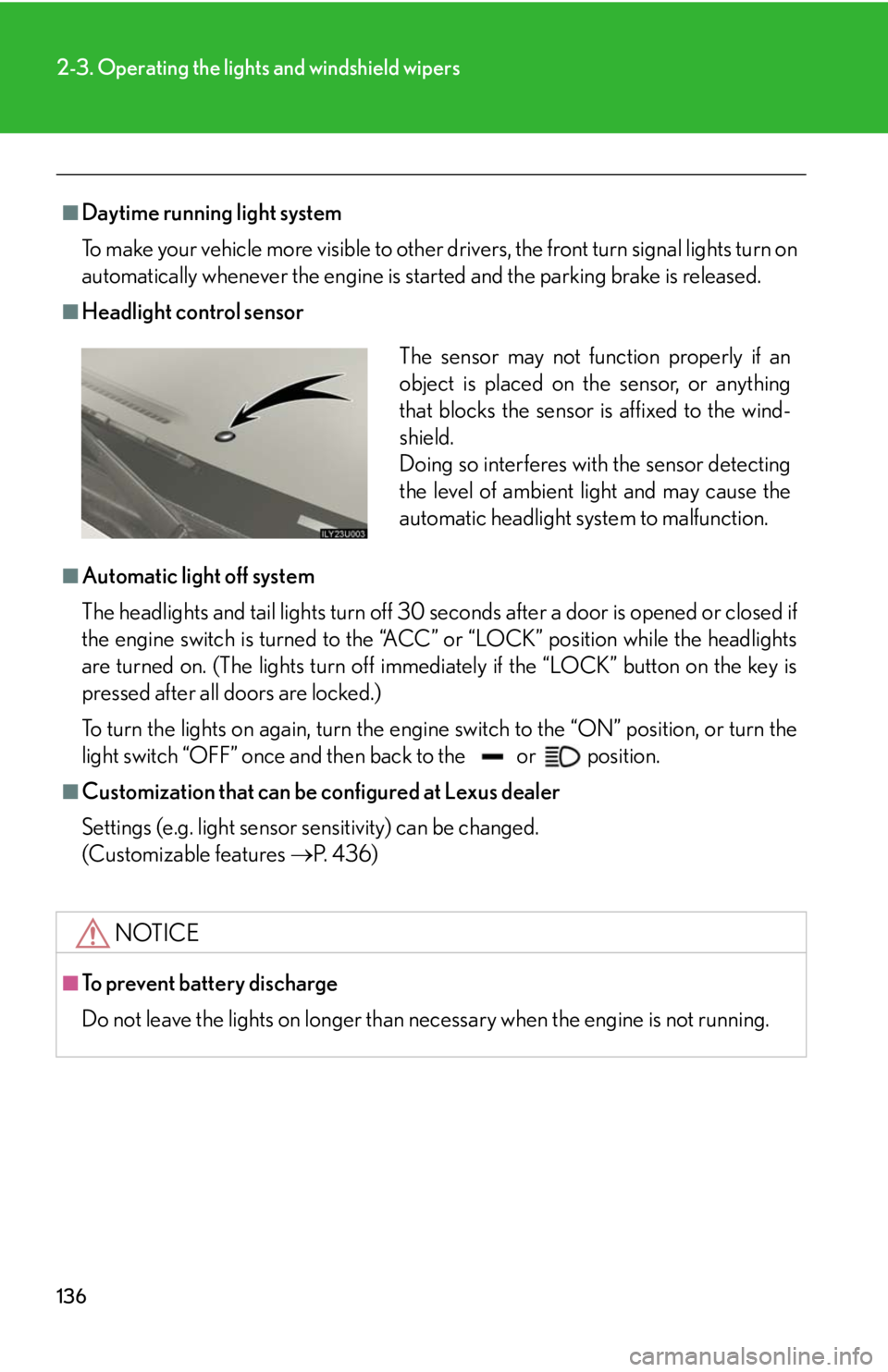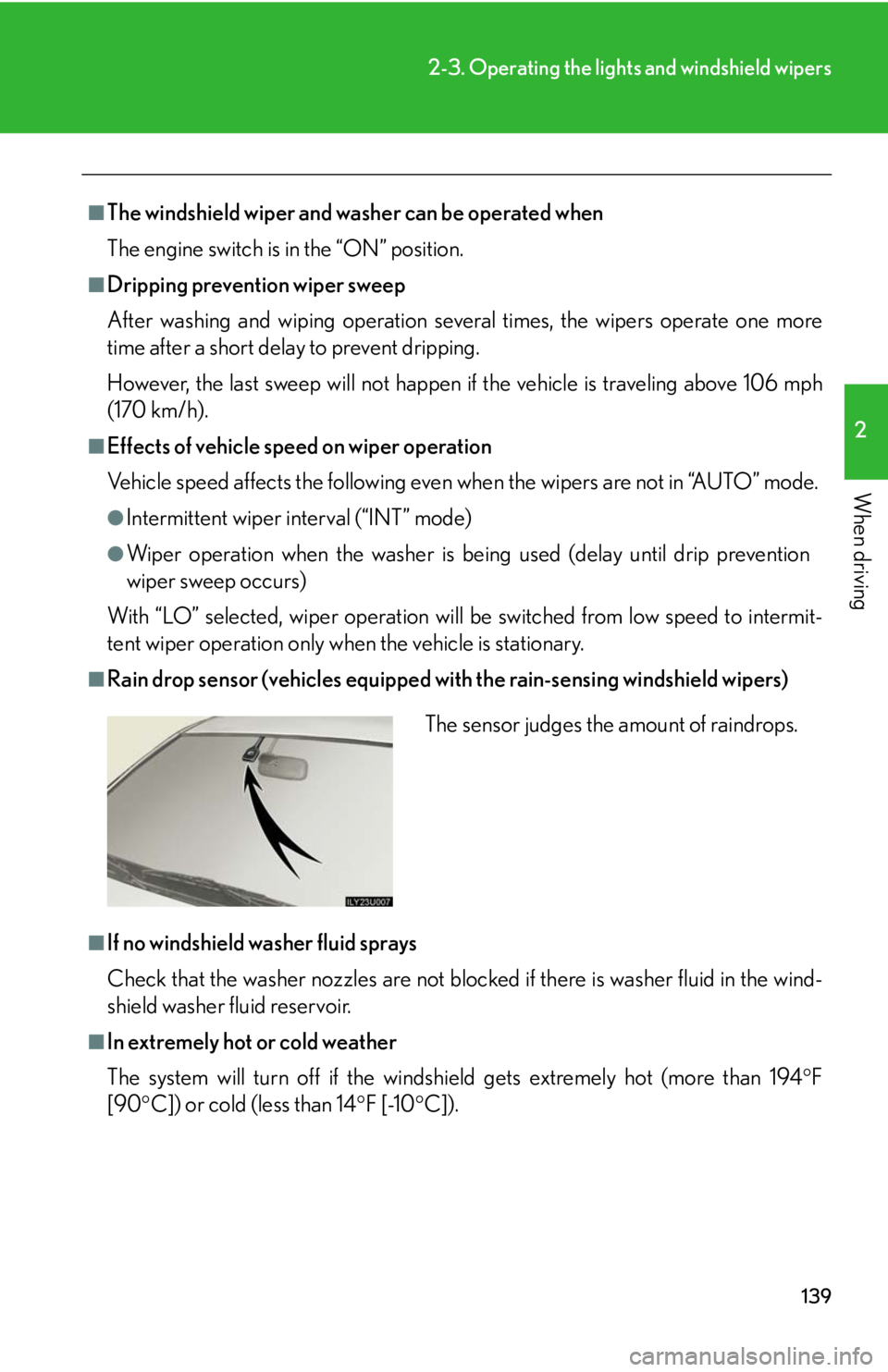lock Lexus GX470 2008 Operating the lights and windshield wipers / LEXUS 2008 GX470 (OM60D82U) Workshop Manual
[x] Cancel search | Manufacturer: LEXUS, Model Year: 2008, Model line: GX470, Model: Lexus GX470 2008Pages: 458, PDF Size: 7.3 MB
Page 120 of 458

120
2-1. Driving procedures
CAUTION
■When starting the engine
Always start the engine while sitting in the driver’s seat. Do not press the accelera-
tor pedal while starting the engine under any circumstances.
Doing so may cause an accident resu lting in death or serious injury.
■Caution while driving
Do not turn the engine switch to the “LOCK” position.
If in an emergency, you must turn the engi ne off while the vehicle is moving, turn the
key to only to the “ACC” position.
NOTICE
■To prevent battery discharge
Do not leave the engine switch in the “ACC” or “ON” position for long periods with-
out the engine running.
■When starting the engine
●Do not race the cold engine.
●If the engine becomes difficult to start or stalls frequently, have the engine
checked immediately.
Page 130 of 458

130
2-2. Instrument cluster
■Indicators
The indicators inform the driver of th e operating state of the vehi-
cle’s various systems.
Turn signal indicator
( P. 1 2 4 )“RSCA OFF” indicator
(P. 8 9 )
Headlight high beam indi-
cator ( P. 1 3 5 )Downhill assist control
system indicator
( P. 1 5 7 )
(U.S.A.)
Headlight indicator
( P. 1 3 5 )
(U.S.A.)
Engine oil replacement
reminder light ( P. 3 8 4 )
(Canada)
Tail light indicator
( P. 1 3 5 ) Slip indicator
(P. 1 6 0 )
Security indicator
(P. 7 0 ) “VSC OFF” indicator
(P. 1 4 7 )
Shift position indicators
(P. 121)Center differential lock
indicator ( P. 1 4 7 )
Height control indicator
( P. 1 5 0 ) “AIR BAG ON” indicator
( P. 9 0 )
Automatic transmission
second start indicator
( P. 122)“AIR BAG OFF” indicator
( P. 9 0 )
Cruise control indicator
( P. 1 4 2 )
*
*
*
*
*
*
*
Page 132 of 458

132
2-2. Instrument cluster
Trip information display
The trip information display presents the driver with a variety of driving-
related data.
Trip information display•Clock(P. 2 6 6 )
• Outside temperature display
( P. 2 6 8 )
• Average fuel consumption
• Current fuel consumption
• Driving range
• Average vehicle speed
• Barometer
• Altimeter
• Driving time
Display items can be switched
by pushing the “MODE” button.
Page 136 of 458

136
2-3. Operating the lights and windshield wipers
■Daytime running light system
To make your vehicle more visible to other drivers, the front turn signal lights turn on
automatically whenever the engine is started and the parking brake is released.
■Headlight control sensor
■Automatic light off system
The headlights and tail lights turn off 30 seconds after a door is opened or closed if
the engine switch is turned to the “ACC” or “LOCK” position while the headlights
are turned on. (The lights turn off immedi ately if the “LOCK” button on the key is
pressed after all doors are locked.)
To turn the lights on again, turn the engine switch to the “ON” position, or turn the
light switch “OFF” once and th en back to the or position.
■Customization that can be configured at Lexus dealer
Settings (e.g. light sensor sensitivity) can be changed.
(Customizable features P. 4 3 6 )
NOTICE
■To prevent battery discharge
Do not leave the lights on longer than necessary when the engine is not running.
The sensor may not function properly if an
object is placed on the sensor, or anything
that blocks the sensor is affixed to the wind-
shield.
Doing so interferes with the sensor detecting
the level of ambient light and may cause the
automatic headlight system to malfunction.
Page 139 of 458

139
2-3. Operating the lights and windshield wipers
2
When driving
■The windshield wiper and washer can be operated when
The engine switch is in the “ON” position.
■Dripping prevention wiper sweep
After washing and wiping operation seve ral times, the wipers operate one more
time after a short delay to prevent dripping.
However, the last sweep will not happen if the vehicle is traveling above 106 mph
(170 km/h).
■Effects of vehicle speed on wiper operation
Vehicle speed affects the following even when the wipers are not in “AUTO” mode.
●Intermittent wiper interval (“INT” mode)
●Wiper operation when the washer is be ing used (delay until drip prevention
wiper sweep occurs)
With “LO” selected, wiper operation will be switched from low speed to intermit-
tent wiper operation only when the vehicle is stationary.
■Rain drop sensor (vehicles equipped with the rain-sensing windshield wipers)
■If no windshield washer fluid sprays
Check that the washer nozzles are not blocked if there is washer fluid in the wind-
shield washer fluid reservoir.
■In extremely hot or cold weather
The system will turn off if the windshield gets extremely hot (more than 194 F
[90 C]) or cold (less than 14 F [-10C]).
The sensor judges the amount of raindrops.
Page 146 of 458

146
2-4. Using other driving systems
Four-wheel drive system
Use the four-wheel drive control lever and center differential lock button
to select following transfer and center differential modes.
Four-wheel drive control lever
“L” (low speed position)
Driving requiring maximum power and traction such as climbing or
descending steep hills, off-road driving and hard pulling in sand or mud.
“N” (neutral position)
No power is delivered to the wheels.
“H” (high speed position)
Normal driving on all types of roads.
Page 147 of 458

147
2-4. Using other driving systems
2
When driving
■The four-wheel drive control lever can be operated when
●The engine switch is in the “ON” position,
●The shift lever is in the “N” position, and
●The vehicle is stopped completely.
Center differential lock/unlock buttonUse this button when your vehi-
cle’s wheel gets stuck in a ditch
or when you are driving on a
loose or bumpy surface.
Page 148 of 458

148
2-4. Using other driving systems
■The center differential lock/unlock button can be operated when
●The engine switch is in the “ON” position, and
●The four-wheel drive control lever is in the “H” or “L” position.
■Locking/unlocking the center differential
●When the center differential is locked, VSC is automatically turned off. (The
center differential lock and “VSC OFF” indicator lights come on.)
●If the operation is not completed, the center differential lock indicator blinks. If
the indicator light does not go off when unlocking the center differential, drive
straight ahead while accelerating or decelerating, or drive in reverse.
●If center differential lock system oper ation is not completed within 5 seconds
while the cruise control system is set, cancel the cruise control system.
CAUTION
■While driving
Never move the four-wheel drive control lever if the wheels are slipping. Doing so
may cause an accident resulting in death or serious injury.
NOTICE
■To prevent damage to the center differential
●Unlock the center differential after the wh eels are out of the ditch or off the loose
or bumpy surface.
●Do not push the center differential lock/u nlock button when the vehicle is corner-
ing or when its wheels are spin ning freely off the ground.
Page 159 of 458

159
2-4. Using other driving systems
2
When driving
Driving assist systems
To help enhance driving safety and performance, the following systems
operate automatically in response to various driving situations. Be aware,
however, that these systems are supplementary and should not be relied
upon too heavily when operating the vehicle.
■ABS (Anti-lock Brake System)
Helps to prevent wheel lock when the brakes are applied suddenly, or if
the brakes are applied while driving on a slippery road surface.
■Brake Assist
Generates an increased level of braking force after the brake pedal is
depressed, when the system detects a panic stop situation.
■VSC (Vehicle Stability Control)
Helps the driver to control skidding when swerving suddenly or turning on
slippery road surfaces.
■ Active traction control
Maintains drive power and prevents the 4 wheels from spinning when
starting the vehicle or accelerating on slippery roads.
■Hill-start assist control
Helps prevent the vehicle from rolling backwards when starting on an
incline or slippery slope. It operates for approximately 5 seconds at maxi-
mum.
■ Limited Slip Differential
Transfers drive power to the rear tires when front tires spin, and vice versa,
in order to improve traction.
■Kinetic Dynamic Suspension System (if equipped)
Kinetic Dynamic Suspension System helps to significantly enhance han-
dling response by reducing roll stiffn ess of the suspension stabilizer bars
through means of a hydraulic control system.
Page 166 of 458

166
2-5. Driving information
CAUTION
■Off-road driving precautions
Always observe the following precautions to minimize the risk of serious personal
injury or damage to your vehicle:
●Drive carefully when off the road. Do not take unnecessary risks by driving in
dangerous places.
●Do not grip the steering wheel spokes wh en driving off-road. A bad bump could
jerk the wheel and injure your hands. Keep both hands and especially your
thumbs on the outside of the rim.
●Always check your brakes for effectiveness immediately after driving in sand,
mud, water or snow.
●After driving through tall grass, mud, rock, sand, rivers, etc., check that there is no
grass, bush, paper, rags, stone, sand, etc. adhering or trapped on the underbody.
Clear off any such matter from the underbody. If the vehicle is used with these
materials trapped or adhering to the underbody, a breakdown or fire could occur.
●When driving off-road or in rugged te rrain, do not drive at excessive speeds,
jump, make sharp turns, strike objects, etc. This may cause loss of control or vehi-
cle rollover causing death or serious injury. You are also risking expensive dam-
age to your vehicle’s suspension and chassis.
NOTICE
■To prevent the water damage
Take all necessary safety measures to ensure that water damage to the engine or
other components does not occur.
●Water entering the engine air intake will cause severe engine damage.
●Water entering the automatic transmission will cause deterioration in shift quality,
locking up of your transmission accompanied by vibration, and ultimately dam-
age.
●Water can wash the grease from wheel bearings, causing rusting and premature
failure, and may also enter the differentials, transmission and transfer case, reduc-
ing the gear oil’s lubricating qualities.